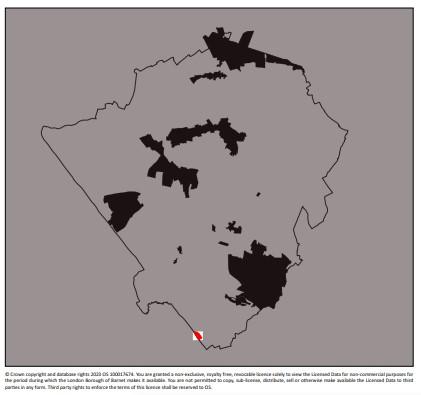Railway Terraces conservation area
Skip to:
Location
The conservation area is situated within Cricklewood in the south western corner of the borough and lies within the Childs Hill Ward. Childs Hill is the twelfth largest of Barnet’s wards with an area of 3.1 square kilometres. With 19,460 residents in 2012, Childs Hill is the most populous ward in Barnet.
The Railway Terraces sit between Cricklewood Broadway to the south west, the Jewson depot to the east and the Cricklewood Curve line to Acton in the north.
The railway acts as a barrier to through traffic on two sides of the conservation area whilst a children’s playground and timber yard border the south-eastern side.
The Cricklewood Broadway forms a further distinct edge to the conservation area along its western side and forms the boundary with the London Borough of Brent.
Gratton Terrace is the western most road in the conservation area, separated from Cricklewood Broadway by a narrow, landscaped bank and the shops of Burlington Parade. Terraces of railway cottages run parallel to Gratton Terrace at the rear. Vehicular access to these cottages is only possible from Cricklewood Broadway via an entrance at the southern end of Gratton Terrace, and steps provide access to pedestrians from Cricklewood Broadway to the northern part of Gratton Terrace
The conservation area is almost entirely residential in nature with approximately 180 houses and 52 flats registered. Some properties, particularly in Gratton Terrace, have been converted to HMO use, but in several cases this has taken place without the benefit of planning permission.
Contains Ordnance Survey data © Crown copyright and database right 2023
Description
Edgware Road is within the pre Roman part of Watling Street which crossed the Thames in Lambeth and ran to St Albans by Roman times. However the Placename Society record ‘le Crickelwode’ as existing in 1294 and by 1860 Cricklewood was a small rural settlement.
In 1866, Midland Railways built the Bedford to St Pancras line with the then named “Childs Hill and Cricklewood Station” opening for passengers in 1870. The arrival of the railway heralded an era of intense expansion for Cricklewood with both housing and factories being built.
In 1892 George Furness opened the first factory in the area, the Imperial Dry Plate Company which dealt with photographic material.
The legacy of the railway and the development it facilitated can clearly be seen in Cricklewood today. There are many industrial sites and early suburban housing estates all bounded and crossed by major transport routes.
The terraces are located within a wider area dominated by the railways and large industrial or commercial units. Prominent neighbouring users include a telephone exchange, bingo hall, a large DIY store, and a Travelodge.
The area is located to the north of the central part of Cricklewood Town Centre, with its numerous individual and independently owned shops along Cricklewood Broadway. To the south and west, in the London Borough of Brent, there are Victorian and Edwardian residential roads built after the advent of the railway.
Documents
Railway Terraces conservation area Character Appraisal
Railway Terraces conservation area map

